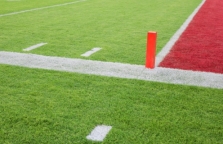Skin infections associated with contact with synthetic turf have received national attention in recent years, but there is no scientific evidence to support concern that the surfaces of infilled synthetic turf (the kind containing crumb rubber found in all fields built since the late 1990's) harbor the Staphylococcus aureus bacterium, the bacteria that cause MRSA, says a recent study. (Serensits, McNitt, and Petrunak 2011).
Two previous studies (Kasakova 2005; Begier 2004) examined the causes and the role of infilled synthetic turf in MRSA outbreaks in football teams. While both studies concluded that turf burns caused by synthetic turf could facilitate skin infection through person-to-person contact, neither suggested that the players contracted the infection directly from bacteria in the synthetic turf itself.

Instead, the studies said that the most likely causes for the outbreaks were poor sanitary conditions in locker rooms and training facilities, and physical contact between players. One of the studies (Begier 2004) also suggested that small cuts from body shaving - an increasingly common practice among young male athletes - provided an avenue for infection.
In the 2011 study, Penn State researchers tested samples collected from infilled synthetic turf fields in Pennsylvania used by all levels of play ranging from elementary to professional. They found that the number of staph microbes that existed on synthetic turf surfaces was low compared to those on natural grass fields.
"Based on the findings of the [staph bacteria] survey, concern that infilled synthetic turf harbours and provides a breeding ground for [staph bacteria] is unwarranted," the authors concluded.
Under non-extreme temperature and very limited light conditions present during the indoor portion of a separate ongoing study at Penn State, the staph bacteria survived on both synthetic and natural turfgrass for multiple days. However, the bacteria did not appear to thrive under those conditions, as the numbers of surviving bacteria decreased significantly with time.
That study, conducted by the Center for Sports Surface Research at Penn State's College of Agricultural Sciences, found that the bacteria on a number of surfaces with which athletes commonly come into contact, such as towels and blocking pads, but that the tested synthetic turf did not contain any S. aureus.
Consistent with these studies, the Centers for Disease Control and Prevention does not view infill turf as a significant source of MRSA infections.
More abrasive
Studies have, however, found that synthetic turf is more abrasive than natural turf grass, and, as a result, breaks in the skin are more common, creating a potential pathway for infection when in contact with an infected surface.
In one study (Begier, 2004), players who sustained turf burns had a risk of infection 7 times higher than that for players without turf burns, suggesting that infection is facilitated by turf burns, although the abrasions were not always directly adjacent to the site of the infection.
The study found that cornerbacks and wide receivers were particularly at risk if they sustain such abrasions, as they have frequent direct person-to-person contact with each other during scrimmage play and drills.
But the studies found no association with the type and timing of care of turf burns, suggesting that avoiding such abrasions entirely would be the best way to prevent infection.
The study says that the specific effects of the characteristics of artificial turf on the risk of abrasion warranted further study, as does the impact of wearing uniforms that cover more skin.
Treatment with Anti-Bacterial Agents not recommended
Treating infill artificial turf surfaces with antimicrobial agents is not recommended, as the medical and scientific communities have not documented any benefit in their use, and there are potential disadvantages.
The CDC says that "[t]here is a lack of evidence that large-scale use (e.g., spraying or fogging rooms or surfaces) of disinfectants will prevent MRSA infections more effectively than a more targeted approach of cleaning frequently-touched surfaces."
This should not be interpreted, however, as preventing the use of cleansing agents such as detergents and soaps to clean infill turf surfaces, provided that such cleaning is performed in accordance with the recommendations of the applicable turf and cleaning agent manufacturers, says the CDC.
Sources:
Centers for Disease Control and Prevention. Cleaning & Disinfecting Athletic Facilities for MRSA. (http://www.cdc.gov/mrsa/community/enviroment/athletic-facilities.html)
Begier et al. 2004. A High-Morbidity Outbreak of Methicillin-Resistant Staphylococcus aureus among Players on a College Football Team, Facilitated by Cosmetic Body Shaving and Turf Burns. Clin Inf Dis. 2004;39:1446-53.
Serensits TJ, McNitt AS, Peterunak DM. Human health issues on synthetic turf in the USA. J Sports Eng. & Tech. 2011;225(Part P). DOI:10.1177/1754337111398407.
Penn State Center for Sports Surface Research. (http://plantscience.psu.edu/research/centers/ssrc)
Aureden K, S. Garber. Methicillin-Resistant Staphylococcus aureus Infections Among Competitive Sports Participants --- Colorado, Indiana, Pennsylvania, and Los Angeles County, 2000- 2003. MMWR 2003;52(33);793-795. (accessed at http://www.apic.org/AM/Template.cfm?Section=Reports1&Template=/CM/Conten... m&ContentFileID=4262)








